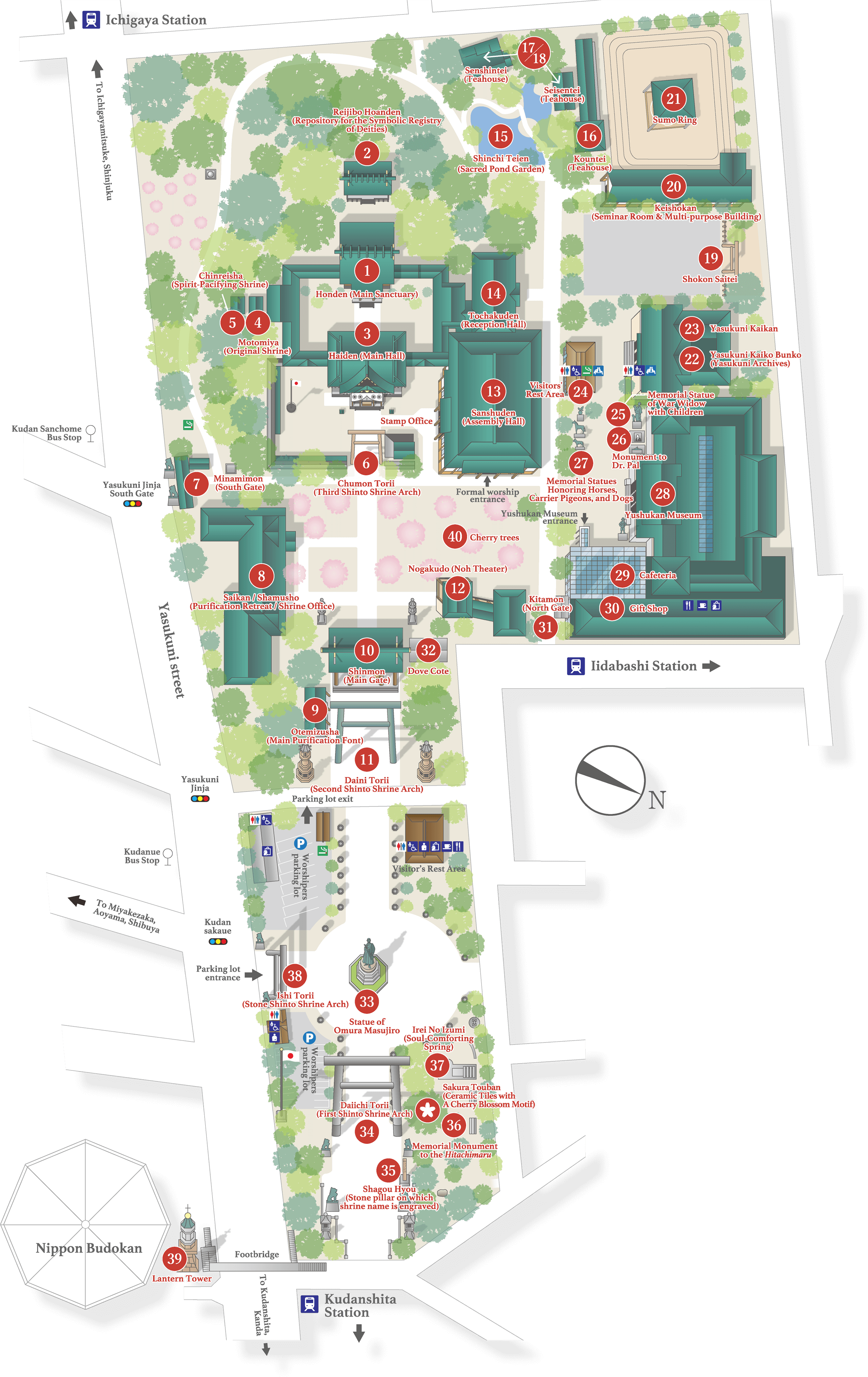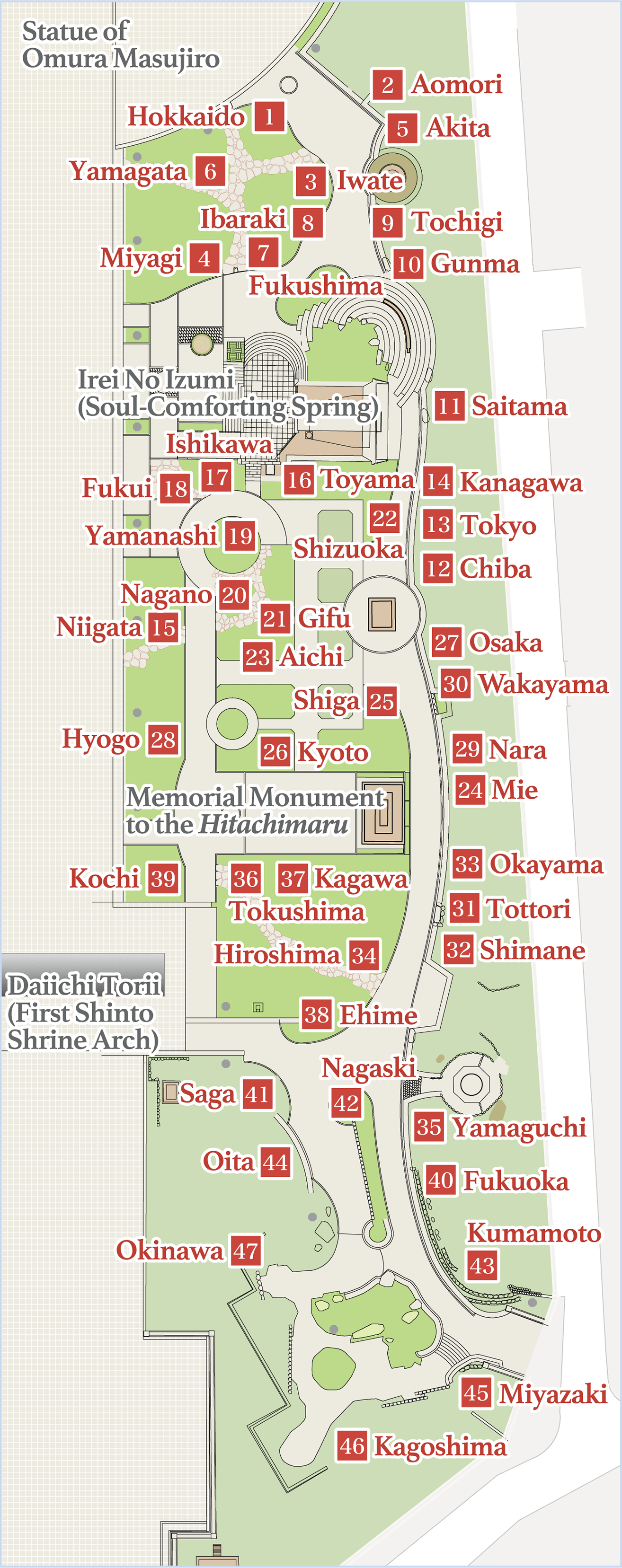- Japanese
- English

 to view a description of the building, statue, etc.
to view a description of the building, statue, etc.


The Main Sanctuary, where the divinities reside, was built in 1872. Renovations started in 1986, and after three years it was restored to its original state in 1989.

This building, located behind the Main Sanctuary, was constructed in 1972. It houses the Symbolic Registers of Souls, lists of the names of all the divinities worshipped here at Yasukuni Jinja. They are written on handmade Japanese paper.

The Main Hall was built in 1901. Its roof was renovated in 1989. In front of it stands a wooden offering box. Visitors come here to pay their respects.

This small shrine was established in Kyoto, in secret, by sympathizers of Imperial loyalists killed during the upheaval that arose in the early days of the Meiji Restoration. Seventy years later, in 1931, it was moved here. It is called Motomiya, or “original shrine,” as it was the prototype of what later became Yasukuni Jinja.

This shrine was built in 1965 to console the souls of every person who has died in wars fought anywhere in the world.

The current torii gate was rebuilt in 2006 from cypress harvested in Saitama Prefecture.

This is the closest gate from Ichigaya Station. The guardian lion-dog statues are the only ones on the entire grounds made of bronze.


The purification basin in the pavilion was presented to Yasukuni Jinja in 1940 by Japanese residents of the United States. It is made of granite, and weighs more than eighteen tons. Before you pay your respects at the Main Hall, please rinse your hands and mouth here.

This magnificent cypress gate was completed in 1934. Each of its two doors bears a chrysanthemum crest measuring 1.5 meters in diameter. Restoration work on the gate, including the replacement of the roof tiles, was undertaken in 1994.

The Second Shrine Gate was built in 1887. It is the biggest bronze torii gate in Japan.

Built in Tokyo’s Shiba Park in 1881, the Noh Theater was presented and moved to Yasukuni Jinja in 1903. Noh dramas and traditional Japanese dance are performed on its stage in honor of the resident divinities.

This hall was rebuilt in 2004. Reception and waiting rooms are available for individuals and groups who wish to worship at the Main Sanctuary.
This is where applications are accepted for those who wish to honor the memory of soldiers fallen in battle, the spirits enshrined at Yasukuni Jinja.
*This is a place for serious worship only.*

The Reception Hall was originally built in 1933 as a waiting chamber for members of the Imperial family, and other distinguished worshippers.

This garden was created early in the Meiji era. Its restoration in 1999 led to it being rediscovered as one of the finest gardens in Japan. It is a strolling garden, and its centerpiece is a waterfall in a setting so serene that visitors may think they are deep in the mountains.

Tea-ceremony workshops by instructors from the Urasenke School are held Monday through Saturday.


The Seisentei Teahouse was built in 1958, while the Senshintei Teahouse was built in 1961. Restoration work on both was undertaken from 2000 to 2001.

This is where memorial services used to be held to summon the spirits of the dead before enshrining them together.

In 1938, a dressing and waiting room for wrestlers was built next to the Sumo Ring, but it gradually deteriorated with age. In order to make it usable for a variety of purposes in addition to its existing function as a dressing room, such as trainings and seminars for worshippers, reconstruction work began as part of the 140th anniversary projects, and was completed in 2010.

In 1869, a sumo-wrestling exhibition was held at Yasukuni Jinja to celebrate the shrine’s founding. Since then, exhibitions by professional sumo wrestlers, including grand champions or Yokozuna, take place at the Annual Spring Rites almost every year. The facility becomes filled with many people who enjoy the matches free of charge.

These archives opened on October 7, 1999, house 100,000 volumes. The collection includes reference materials that describe the circumstances under which the divinities of Yasukuni Jinja died, as well as source materials for research on modern history. We welcome anyone who wishes to learn more about the divinities enshrined here or conduct research on modern history.

This building was completed in 1934. The Yasukuni Archives and a free rest area for visitors are located on the first floor.

This area includes restrooms, vending machines, and a space for smokers. It was newly constructed as part of the 150th anniversary projects, and completed in 2016.

This statue, completed in 1974, is a tribute to the many war widows who did such a fine job of raising their children in the face of incredible hardship and loneliness. It was commissioned by their children, now adults, and symbolizes their gratitude to their mothers.

This monument was completed in 2005 to honor Dr. Radha Binod Pal, the representative judge from India during the International Military Tribunal for the Far East (commonly known as the Tokyo Tribunal). Among all the judges on the tribunal, he was the only one who judged all the defendants as not guilty.

This bronze, life-sized statue of a fine steed was presented to Yasukuni Jinja in 1958 to honor the memory of the horses that served the military loyally.
The statue of a carrier pigeon atop a globe honors the birds that were faithful messengers in wartime. Made of bronze and named “Pigeons and the Globe,” it was presented to Yasukuni Jinja in 1982.
The statue of a German shepherd, also bronze, represents the soldiers’ beloved canine comrades, and was donated to Yasukuni Jinja in March 1992.

The museum was opened in 1882. It is a facility to store and exhibit relics. The building was repaired and expanded in 2002.

The cafeteria “Yui” located in the first-floor entrance hall of the Yushukan Museum offers not only tea, but also exclusive menu items like “Navy Curry” authentically reproducing one of the Japanese Navy’s original recipes.
> menu

The gift shop offers a selection of souvenirs for worshippers and relevant books.

This is the closest gate from Iidabashi Station.

Almost 500 white doves live on the grounds of Yasukuni Jinja. It is said that only one in 10,000 doves is pure white.

Omura Masujiro (1824-1869), the founder of the modern Japanese Army, devoted a great deal of effort to the establishment of Yasukuni Jinja. This statue installed in 1893 was Japan's first Western-style statue.

Japan's largest torii, or shrine gate, was erected in 1921. Described in a poem as “the great gate that seems to pierce the sky,” it was a notable landmark for visitors. But because of damage from exposure to wind and rain over the years, the gate was removed in 1943. The present torii was dedicated in 1974 by comrade in arms. It is twenty-five meters in height.


In 1904 during the Russo-Japanese War, the army transport vessel Hitachimaru was attacked by a Russian fleet from Vladivostok, and sunk with over one thousand men on board. A memorial service is held in front of this monument every year on June 15.

This installation was dedicated in 1967 in memory of the soldiers who gasped their last breaths on the unfamiliar soil of distant battlefields, begging their mothers for water.
The sculpture is an abstract representation of a loving mother tenderly pouring clean water.

Built in 1932. This is the entrance to a parking lot.
→Access

This tower with a continuously burning light was completed in 1871, and once served as a beacon for ships passing through the harbor of Shinagawa. It was moved from the other side of the road to its current location in 1925 due to improvement work on Kudan Slope.

The cherry trees of Yasukuni Jinja have their origin in the cherry trees planted here at Kudan for the first time in 1870, the year after the Sanctuary of Yasukuni Jinja (known as Shokonsha at the time) was built. These beautiful trees, long considered a symbol of Japan, embody pride for the divinities of the shrine. Today there are about 600 cherry trees here, many of which are Somei Yoshino and Yamazakura varieties. Each year, the Japan Meteorological Agency bases its cherry-blossom flowering forecasts on the cherry trees at Yasukuni Jinja.
These ceramic tiles with a cherry blossom motif were created using clay from each of Japan’s forty-seven prefectures with connections to the enshrined spirits and dedicated by local potters, as a commemorative project to celebrate Yasukuni Jinja’s 150 anniversary.
Each tile is crafted using traditional techniques to honor the enshrined spirits, and expresses deep, everlasting reverence for the departed.
They were set in this spot, named the Soul-Comforting Garden, in order to guide worshippers to the Main Sanctuary.


Source of Raw Material: Kato-gun and Nayoro-shi, Hokkaido
Potter: Seigo Minami

Source of Raw Material: Gosyogawara-shi, Aomori
Potter: Tsugaru Kanayama-yaki

Source of Raw Material: Hanamaki-shi, Iwate
Potter: Yuichi Yukinoura

Source of Raw Material: Kami-gun, Miyagi
Potter: Satomi Tashiro

Source of Raw Material: Minamiakita-gun, Akita
Potter: Hideki Sato

Source of Raw Material: Nagai-shi, Yamagata
Potter: Osamu Wakui

Source of Raw Material: Onuma-gun, Fukushima
Potter: Toshihiro Munakata

Source of Raw Material: Kasama-shi, Ibaraki
Potter: Kozan-gama

Source of Raw Material: Oya-machi, Utsunomiya-shi, Tochigi
Potter: Koichi Takita, Siu Takita

Source of Raw Material: Takasaki-shi and Shibukawa-shi, Gunma
Potter: Tatsuhiko Nagumo

Source of Raw Material: Hiki-gun, Saitama
Potter: Kiyoshi Hara

Source of Raw Material: Wakaba-ku, Chiba-shi, Chiba
Potter: Norio Kamiya

Source of Raw Material: Chiyoda-ku, Shibuya-ku, and Hachioji-shi, Tokyo
Potter: Junko Nakauchi

Source of Raw Material: Asigarakami-gun, Kanagawa
Potter: Sansei Suzuki

Source of Raw Material: Nishikan-ku, Niigata-shi, Niigata
Potter: Susumu Takai

Source of Raw Material: Imizu-shi, Nakaniikawa-gun, and Oyabe-shi,Toyama
Potter: Takeshi Ikegami

Source of Raw Material: Komatsu-shi, Ishikawa
Potter: Isokichi Asakura

Source of Raw Material: Nyu-gun, Fukui
Potter: Kosei Masudaya

Source of Raw Material: Yamanashi-shi, Yamanashi
Potter: Kunio Watanabe

Source of Raw Material: Tomi-shi, Nagano
Potter: Yoshitaka Sakurai

Source of Raw Material: Toki-shi, Gifu
Potter: Kobei Kato VII

Source of Raw Material: Shizuoka-shi, Shizuoka
Potter: Syunjuka Godai

Source of Raw Material: Seto-shi, Aichi
Potter: Shigetoshi Kato

Source of Raw Material: Yokkaichi-shi, Mie-gun, and Inabe-shi, Mie
Potter: Ichizo Mori

Source of Raw Material: Shigaraki-cho, Koka-shi, Shiga
Potter: Kiyotsugu Sawa

Source of Raw Material: Kamigyo-ku, Kyoto-shi, Kyoto
Potter: Masakazu Hoki

Source of Raw Material: Rokutantsuchi, Osaka-shi, Osaka
Potter: Katsuhiko Kitano

Source of Raw Material: Tamba Sasayama-shi, Hyogo
Potter: Masahiko Ichino

Source of Raw Material: Shiki-gun, Nara
Potter: Karako-gama

Source of Raw Material: Nishimuro-gun, Wakayama
Potter: Seiho Samukawa

Source of Raw Material: Tottori-shi, Tottori
Potter: Akira Sakamoto

Source of Raw Material: Izumo-shi, Unnan-shi, and Gotsu-shi, Shimane
Potter: Shin Tatano

Source of Raw Material: Bizen-shi and Setouchi-shi, Okayama
Potter: Ryuichi Kakurezaki

Source of Raw Material: Higashihiroshima-shi, Hiroshima
Potter: Kosai Yamane

Source of Raw Material: Hagi-shi and Hofu-shi, Yamaguchi
Potter: Masanao Kaneta

Source of Raw Material: Naruto-shi, Tokushima
Potter: Yukio Mori

Source of Raw Material: Mitoyo-shi, Kagawa
Potter: Tatsuya Orita

Source of Raw Material: Tobe-cho, Iyo-gun, Ehime
Potter: Kimio Yamada

Source of Raw Material: Kochi-shi, Kochi
Potter: Hiroyuki Doi

Source of Raw Material: Tagawa-gun, Fukuoka
Potter: Mamoru Kumagaya

Source of Raw Material: Arita-cho, Nishimatsuura-gun Arita-cho, Saga
Potter: Manji Inoue

Source of Raw Material: Hasami-cho, Higashisonogi-gun, Nagasaki
Potter: Keita Ishimaru

Source of Raw Material: Shodai, Arao-shi, Kumamoto
Potter: Taisyu Inoue

Source of Raw Material: Hita-shi, Oita
Potter: Takumi Sakamono

Source of Raw Material: Kitamorokata-gun, Miyazaki
Potter: Kiraku-toen

Source of Raw Material: Satsumasendai-shi, Kagoshima
Potter: Satoshi Uchiyama

Source of Raw Material: Kunigami-gun, Okinawa
Potter: Hideo Miyagi